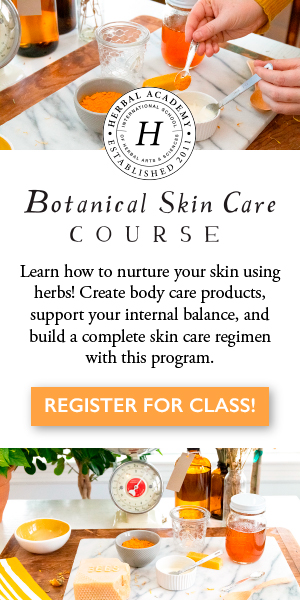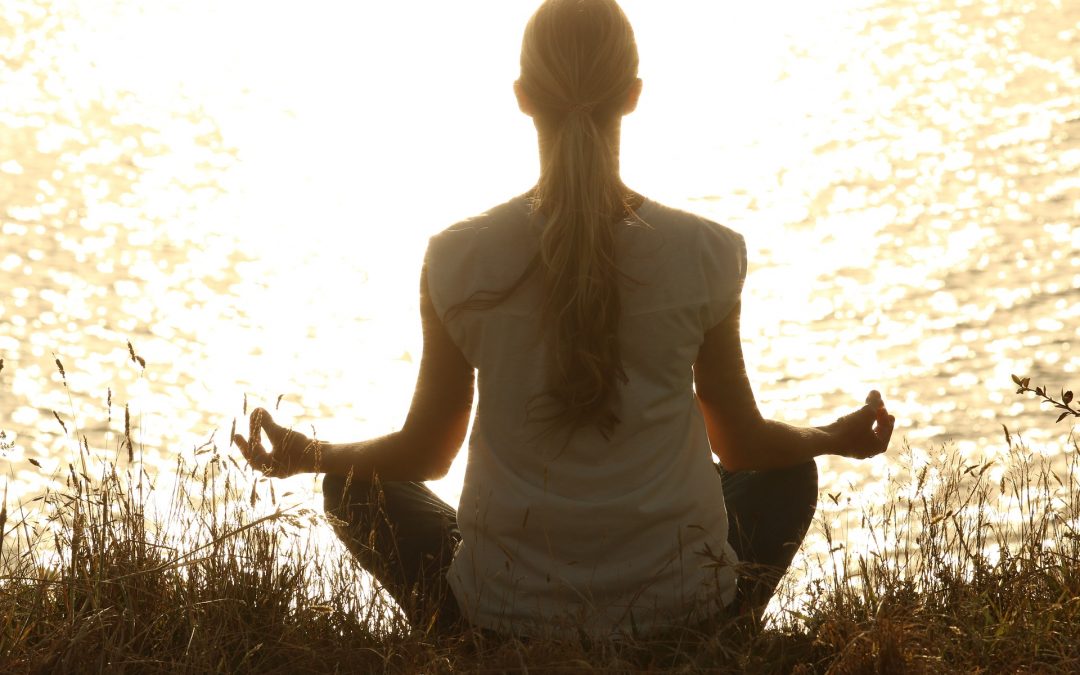
by Leslie Moldenauer | | Mind
I have heard all the rebuttals about how hard it is to meditate. Many people give up before they even really give it a valiant effort. My response to the struggle is typically there is a reason for the difficulty, your mind is thinking about too many things. Yes, I do realize the incredible irony in that statement. There are things that we can do to help ourselves, and we should try them before we expect to be able to accomplish the goal. Mindfulness is much of the same. One of the main problems is that we over-schedule our lives, take on way too much, and pressure ourselves with a wide variety of ‘shoulds’. It is truly no surprise that getting our mind and body to quiet is a hard task, sometimes seemingly impossible. It is a re-training of our habits. It does take work. It can be for everyone. Can mindfulness and meditation practices help to manage anxiety? The answer is a resounding yes!
Fhew….that is good news, right?
Everyone is feeling added stress right now unless we never turn on a piece of electronics, and never talk to anyone about the happenings in the world, not many of us are immune. The research on meditation shows us that not only can meditation be helpful on some level for each and every one of us, but it also helps to calm us and keep us centered despite what is going on around us. That is the ultimate goal of these practices, to learn to be calm on the inside. To have healthier responses to struggle. This does not mean we will or should be happy at every moment. I do not want that to be misunderstood. We absolutely need to process our lives, not avoid them. What is important is that mindfulness and meditation practices not only help to manage anxiety, but they can make us so much happier as a whole.
They are two of the BEST coping mechanisms I know.
I do not want you to think of the word coping as a negative connotation. The definition of coping is “investing in one’s own conscious effort, to solve personal and interpersonal problems, in order to try to master, minimize or tolerate stress and conflict” (Wiki, 2020).
Coping is incredibly difficult without help, so #1 is to just love ourselves, even with our struggles. Our children need our help! I do not want to sound like a negative Nancy here, but the world is only going to become a more challenging place to live in, and we need to step up to the challenges and learn more skills. It really is the only way to function while in the eye of the storm.
I have great expertise and experience here in my own life. I speak from years of scouring books, taking online classes, reading studies, and having a meditation and mindfulness practice 15 years strong because I needed the skills. I never miss a day of meditation, and I practice mindfulness throughout every single day.
My story….just a piece
When I began my practice of meditation, my father had just passed, and I was thick in grief and grasping at anything that could help me to have a moment of peace in my head to function. As I type this, tears form in my eyes. Like so many of you have experienced grief in your lives, devastating grief is a pain like no other, and although we all grieve differently, we all need(ed) help on some level. I needed quite a lot. My father suffered so terribly that it took me the better part of one year to even be able to remember him healthy and happy and begin to process my grief in a healthier way. Meditation helped me to get me there. It helped to quiet my thoughts just a little so I could breathe. It helped me be a good mother to my then 6 month and 18-month-old boys. Alongside holistic therapy and hypnosis, it helped me to process and heal my grief.
I went to a yoga therapist who was teaching a meditation class, I walked in not sure what the hell I was doing. I was nervous and not sure it would help. I stayed for over a decade.
In the years following my fathers’ passing, I underwent multiple surgeries in a very short time period and was involved in a severe car accident that left me with debilitating chronic pain. I endured a divorce of a 20-year marriage and quickly became a single mom with no coparent. My adrenal glands began to suffer at the loss of my father and continued on a downward spiral through the years. It was a lot, and I needed many tools to help sustain me so that I could begin to heal. Why have I shared these dark points of my life? So that you know you are not alone in your struggles. If you feel like you have nowhere to turn, no help, and are losing hope…..I want to shine my light on you. Despite the struggles and illness that I endured over the years, despite the years of chronic pain and loss, I got through it with the help of the practices I have learned, and truthfully now I am not able to be without them.
Meditation
I enjoy meditation in a comfortable seated position, or even lying down if I am in pain or exhausted, but never to sleep. You do not necessarily need to sit cross-legged, but that is the traditional way. I like to sit atop a large meditation pillow, but any pillow will do. You do not need to purchase special tools. I also roll up a blanket or large towel and wrap it around and under my legs/knees to keep my feet comfortable. Do whatever you have to do in order to be comfortable. Let your hands rest on your legs. If you tend to round your shoulders, pull your arms closer to your body and turn your palms up to the sky.
Another thing that helps me if my mind is full is to move my body first. I typically do at least 20 minutes of yoga, but a walk outside in nature works, as does dancing it out to a favorite song or two. If you just sit and expect your mind to cooperate, you might struggle.
You can begin your meditation with pranayama breathing. These are specific breathing practices to help get you centered and your mind quiet. Follow this link here to learn a basic practice, then come back and continue on.
It is also important to mention that your mind will not be completely quiet, perhaps ever. I mentioned I have been doing this for over a decade, and I still have thoughts during meditation. Truly the goal here is to acknowledge the thought and give it permission to float away until a later time. Picturing them floating out the window or away on a cloud might be helpful. Give it a try. Sometimes I say (in my head), “I see you”, and then pull myself back. Sometimes I have to pull myself back a handful of times, sometimes dozens of times. Just keep going. You will always be better off than when you started.
Meditation breathing should be using your nose only. Inflating your belly on the inhale, and letting it collapse on the exhale. When I taught my children how to meditate, I had them say so (to self) on the inhale and hum (to self) on the exhale. That helps combat thoughts as well. My teacher taught me good qualities of breath are even, without pause, without sound, and without force. Do not focus on counting or having it perfect. Just let it be relaxed.
The best thing you can do is to try it! Keep trying it! Some days will not be the greatest, while others will be great. Every day is exactly as it should be. You are learning something new. Give yourself grace.
Mindfulness
Learning to practice mindfulness is really crucial to life. Over ten years ago I read Thich Nhat Hanh’s, “Peace Is Every Step.” It was one of many books that changed my life.
The beginning of Mindfulness is breath. This is what brings you back to the present moment. This does not need to be similar to meditation. Mindfulness is purposefully focusing your intention on the current moment and nothing else and accepting it exactly as it is. This should be cultivated in everything you do, in every moment of the day.
Here is one example of a mindful experience, happening much slower than you are reading it of course:
Begin to really notice things around you. You open the front door and head out for a walk around the neighborhood. Hear and acknowledge the sound of your feet hitting the street. Really see the trees, flowers, and grass blowing in the wind. You pass someone on the street. Smile at them, not just a casual look right through them, smile, but really mean the smile, be present with them and lock eyes for that moment. Acknowledge the transfer of energy that takes place. Feel the breeze on your skin. Is it cool or warm? Can you feel the hairs moving on your arm? Is the sun shining on you? Can you really feel your skin smile as this is what it has been waiting for? Can you hear birds? Really open your ears and listen. Focus on this sense. What is in their birdsong? Look up at the sky and see clouds floating by. Can you make any of them into shape? Contemplate how big the universe is and how lucky and grateful you are to be a part of it; yet how small you are in it. Feel your feet hit the ground. Feel the sensations in your feet, your legs, your back, and your arms. Maybe you notice a bee pollinating a flower. Stop walking and get up close. Look at all of the pollen on the bee’s legs and body. Think about the cycle of life. Thank the bee for all of the flowers, fruit, vegetables, etc. Smile and continue walking. This is one small example of true mindfulness. Truly being in the moment.
How do you think you would feel after this walk? I think it would be the best walk you have had in some time.
Hanh made one small statement in his book that I carry with me always, and when I feel overwhelmed at any moment I stop and use it. It goes something like this: “I inhale, I am a mountain, I exhale, and I am solid.” Sitting or standing strongly and closing your eyes is the best way to center while saying this. Another thing I have adapted from the book is: I imagine a willow tree. One of the bigger trunked trees, solid, strong, grounded. Its branches are very pliable, bendable, flowing. Imagine this when you feel overwhelmed. You are graceful and bendable, but you do not break.
The more you practice mindfulness during your day, the calmer your overall demeanor will be. It can be done while driving, doing dishes, cooking a meal, and while at work. In doing this your brain is being retrained and you will be able to find calmer in your day, and in your mind-body.
I have provided a few resources for your below to further your exploration of these two practices. My hope is that you try it and teach it to your children. As we move forward in this world, to more coping skills we have, the happier and more resilient we will become. Can mindfulness and meditation practices help to manage anxiety? Try it for yourself and see!
Wishing you abundant health and happiness,
Leslie xo
References
Coping. (2020, September 03). Retrieved September 28, 2020, from https://en.wikipedia.org/wiki/Coping
Hạnh, N. (2013). Peace is Every Step. Bantam/AJP.
Resources
The Little Book of Mindfulness
The Miracle of Mindfulness: An Introduction to the Practice of Meditation
The Tapping Solution: A Revolutionary System for Stress-Free Living
Practicing Mindfulness
Please note that I am not a medical practitioner. The content of this website is provided for general informational purposes only and is not intended as, nor should it be considered a substitute for, professional medical advice. Do not use the information on this website for diagnosing or treating any medical or health condition. If you have or suspect you have a medical problem, promptly contact your professional healthcare provider. By using this website, you assume full responsibility and liability for your own actions.
STRESS! Recognizing when your Nervous System is Dangerously Overactive
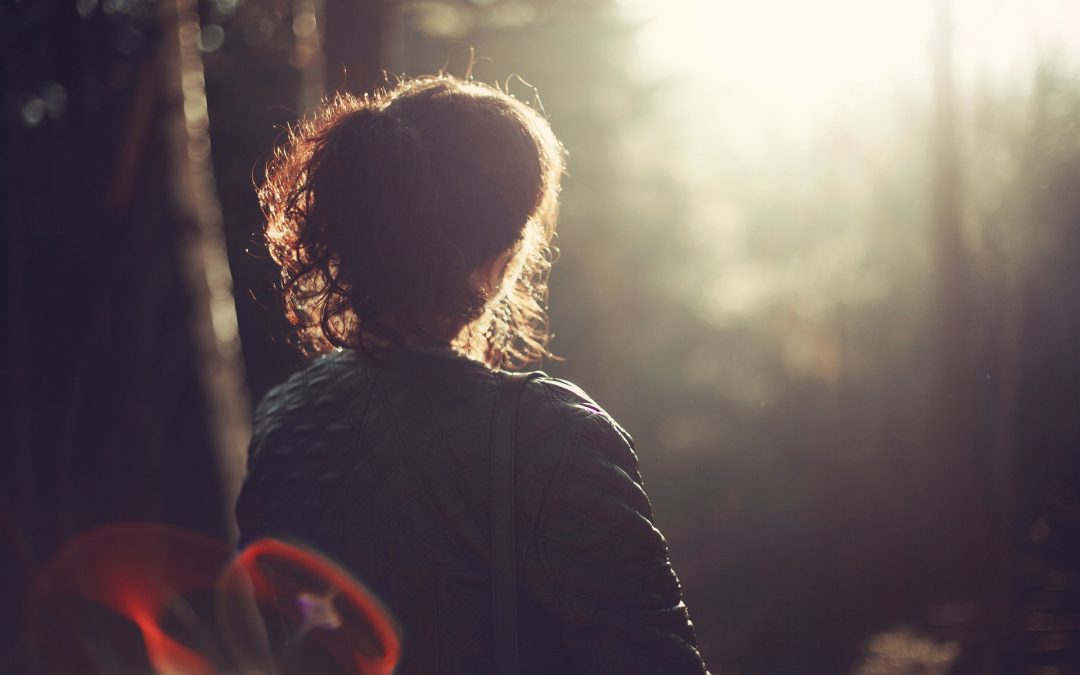
by Leslie Moldenauer | | Mind
Ahh 2020….the year of great challenges both in our government, in our community, in our circles, and in our hearts. This proposes a very important question…How to find balance during the Covid pandemic?
Some may feel that compassion and understanding have been all but forgotten. I too have felt this way at times, especially on social media with keyboard warriors. It is well known that when we operate from fear, we are not ourselves…and there is a lot of fear and uncertainty in the world. I have had to shut off my phone, close my computer, and spend quality time with the person that needs my compassion the most, me. I too have fear. I am not immune, I do not want to give that impression. This is simply the time that I use the tools in my toolbox….and freak out to my soul sister via macro polo. BEST.INVENTION.EVER
What do I do?
I have to practice grounding exercises multiple times a day.
I meditate more than once a day.
I make entries in my journal(s) multiple times a day.
I do mirror work.
I drink calming teas.
I take CBD.
I take herbal tinctures composed of milky oat tops, lavender, and ashwagandha.
I take magnesium
I use essential oils often.
I cry often.
I do so many things to stay true to me, feed my soul, and forgive myself when I falter.
One key piece I have discovered though is what used to work for me quite easily to calm the chaos, to shift energy, feel blissful, and be grounded, now takes so much more work because the world is in chaos too.
Many do not have or use such tools, and are in survival mode at best….therefore I believe we have a great responsibility to make space for others and where they are. (Not to be mistaken for poor behavior)
We all fall down…
We all have off days…
We definitely all have days where we want to get off the roller coaster that is 2020. Finding balance during a pandemic is not something most of us have had to do in our lifetime. One thing that I wish for everyone is the ability to be compassionate with ourselves….when we learn to do that well, we can find it for other people. YES, even those who do not agree with our stance on ANYTHING.
What does self-compassion look like? Self-compassion is being understanding, gentle, and NICE to yourself. Limiting negative self-talk. We are not perfect, we will make mistakes, and it is vital to love ourselves through it. Once we really see what that feels like and looks like, we can begin to offer it to others.
How do you handle disagreements in opinion? From my standpoint, it is important to remember that we all have a very deep story, a lens in which we see all things. Many of us are broken in some way and unfortunately, many lenses have blinders that make them unable to see any view but their own. This in and of itself makes it nearly impossible to be in agreeance on everything. We can agree to disagree. We can both be right, or wrong….it is in the adult communication that ensues that does not further perpetuate chaos that is important right now. Hate and shaming are never ok. I would like to add to be cautious of those that belittle others if they do not share in their opinions, no matter the topic. Unfortunately, communication will almost always break down in these situations.
Our uniqueness is truly beautiful, we can CoeXisT, in the very meaning of that word and ideal created by the image below is an image created by Polish, Warsaw-based graphic designer Piotr Młodożeniec in 2000 (1). The CoeXisT image signifies the capability or desire of humans to live together in peace.

Royalty-free image
We may not all have that capacity right now to have that compassion. I believe that indicates a valuable moment to say no to participate in the dialogue for however long is necessary in order to cultivate it.
It is ok to not have all the answers.
It is ok to pull back.
It is ok to nurture yourself and forget everything else for a little while.
You do not have to make sense of another’s opinions, you do not have to figure out why they are the way they are or say what they say, you just have to look inside, love yourself and let your light continue to radiate out into the world.
It is ok for it to be hard.
Keep shining your light, even if it flickers and shakes.
Click through here for ways to utilize complementary medicine during this time to find balance, harmony, and calm when it is needed the most.
Sending you all abundant health and happiness
Leslie xo
Reference
(1)https://en.wikipedia.org/wiki/Coexist_(image)
Like so many practices in life, I encourage you to become educated on the proper use of essential oils. When using them, please do so cautiously, understanding that there is often misinformation on the internet. You can be assured that I support only educated and proven resources. While essential oils should not be feared they should be respected and used properly to ensure the safety of the individuals using them.
Please note that I am not a medical practitioner. The content of this website is provided for general informational purposes only and is not intended as, nor should it be considered a substitute for, professional medical advice. Do not use the information on this website for diagnosing or treating any medical or health condition. If you have or suspect you have a medical problem, promptly contact your professional healthcare provider. By using this website, you assume full responsibility and liability for your own actions.
STRESS! Recognizing when your Nervous System is Dangerously Overactive
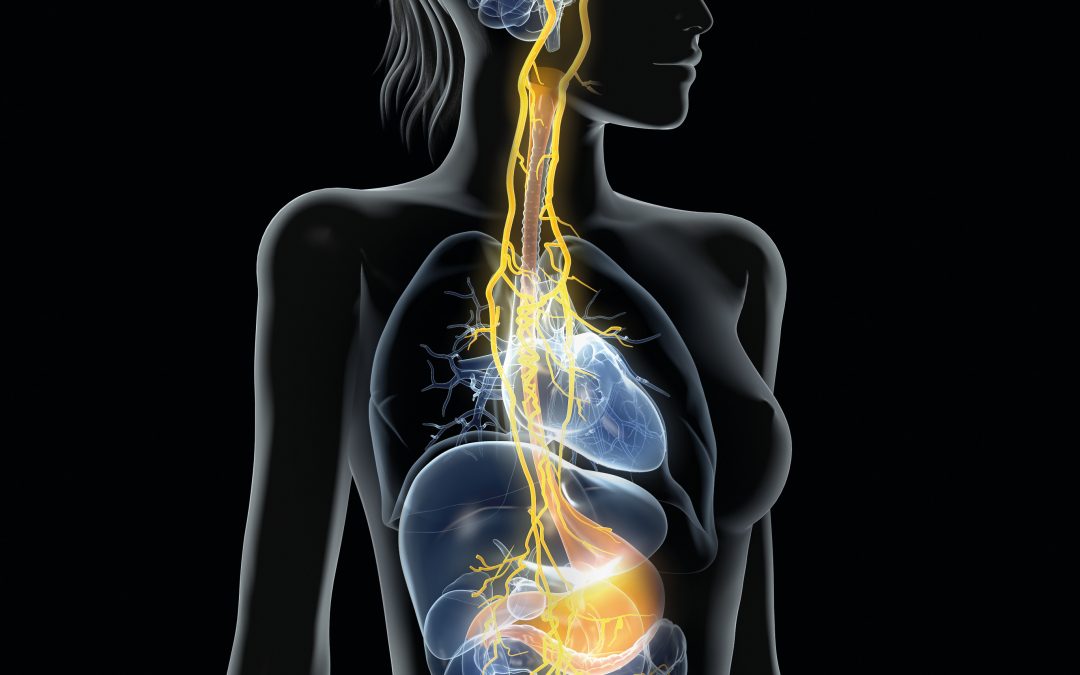
by Leslie Moldenauer | | Body, Mind
Dealing with intense emotions leaves our central nervous system on high alert leaving our vagus nerve weak and unbalanced. What is the connection between our vagus nerve and our central nervous system?
Life has brought more than the typical challenges over the last few months, for all of us. And while our stories are very different, the emotions can be very similar. Fear, uncertainty, exhaustion, and even though many of us have been invited to slow down, our nervous systems have other plans. It is important to really feel them, acknowledge them, unpack them, and look them in the eye.
“We cannot selectively numb emotions, when we numb the painful emotions, we also numb the positive emotions.”― Brené Brown, The Gifts of Imperfection
I have a history of adrenal fatigue and exhaustion, so I have to be hyper-aware of my endocrine health and use all of the tools at my disposal to stay on top of any challenges that come up, and that includes not ignoring anything.
I have spoken a great deal about the branches of our nervous system on social media, those being the sympathetic nervous system (SNS) and our parasympathetic nervous system (PNS).
The SNS, which can help to keep us out of danger, is very important. This is the fight-flight-freeze mechanism of our nervous system. Most of us are stuck in freeze mode as of late, which means our cortisol is always high, and as a result we have a deep level of heaviness and exhaustion. This is termed our allostatic load or in most of our cases overload, which is the wear and tear on our body and mind when under chronic stress.
When we are stuck in freeze mode, it becomes harder and harder for our nervous system to switch over to the parasympathetic system of rest and restore, and this is not a good thing.
A piece of this that is not often talked about is our vagus nerve. The vagus nerve is the 10th cranial nerve with impressive length and function, running from the brain all the way down to the abdomen.
Brain…check
Pharynx…check
Lungs…check
Heart…check
Esophagus…check
Stomach…check
Gallbladder…check
Pancreas…check
Small intestine…check
YES…..the vagus nerve acts on all of these. And when we are dealing with anxiety and depression, strengthening or toning the vagus nerve is a great place to start to begin to heal.
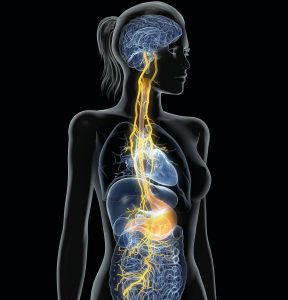
What does that mean you ask?
Toning the vagus nerve is essentially balancing the SNS and PNS. All along the vagus nerve you will find enteric nerve fibers, or our enteric brain. This is really fascinating stuff, the connection from the brain to the gut is essentially working like a 2-way radio. When working well, toned and strong, the communication going both ways is strong and clear. When it isn’t, the radio goes on the fritz.
This is a rudimentary analogy but an accurate one.
Stimulating the vagus nerve is something we should all be doing. A recent study published in 2018 by the Frontiers in Psychology states that there is preliminary evidence that vagus nerve stimulation is a promising add-on treatment for treatment-refractory depression, posttraumatic stress disorder, and inflammatory bowel disease. Treatments that target the vagus nerve increase the vagal tone(1).
You can Google various ways to tone the vagus nerve, but my favorite by far is deep breathing while creating a vibration in the throat (crossing the vagus nerve in the pharynx) through sound therapy.
This works for two reasons. When under high levels of stress and anxiety, we tend to shut down energetically, we stop moving, hunker down and curl up, slump our shoulders forward closing off our heart, and in the process, our SNS is lit up like a light bulb.
When we perform deep breathing and chanting, we are forced to shift over to our PNS system while we are stimulating the vagus nerve.
Singing, humming, chanting, and even gargling stimulates the nerve. Now we cannot gargle all day, but we can incorporate the others quite easily.
Most of take anywhere from 10-15 breaths in one minute. Try to consciously get the number down to 6 breathing deep into the diaphragm. Once you have mastered that, add a hum throughout the length of every exhale. Close your eyes and feel the vibration in your throat, face, and head.
This is just the beginning. I have found a way to incorporate a number of therapies for a powerful way to bring calm quickly, keep the PNS engaged while rewriting limiting beliefs.
My next online course, From Healing to Thriving, Reform your Inner Critic to Ignite your Inner Wisdom is a powerful 4 module course that targets this practice as well as many other engaging exercises to become the best you that you can be.
The launch is set for mid/end of June. If you are interested in being a beta tester (spaces are limited), reach out at Lifeholistically@gmail.com.
Like so many practices in life, I encourage you to become educated on the proper use of essential oils. When using them, please do so cautiously, understanding that there is often misinformation on the internet. You can be assured that I support only educated and proven resources. While essential oils should not be feared they should be respected and used properly to ensure the safety of the individuals using them.
Please note that I am not a medical practitioner. The content of this website is provided for general informational purposes only and is not intended as, nor should it be considered a substitute for, professional medical advice. Do not use the information on this website for diagnosing or treating any medical or health condition. If you have or suspect you have a medical problem, promptly contact your professional healthcare provider. By using this website, you assume full responsibility and liability for your own actions.
Reference
(1) https://www.ncbi.nlm.nih.gov/pmc/articles/PMC5859128/
STRESS! Recognizing when your Nervous System is Dangerously Overactive

by Leslie Moldenauer | | Mind
So many of us are living in a state of chaos in our minds. When we hear of another meditating, we envision a buddha sitting atop a pillow or someone chanting ohm or “latinease” while holding thumb to middle finger. While this may make me chuckle a little bit, there is, in fact, some truth to it. Other common thoughts are meditation is not for me. I can’t sit and not think. I do not have time to meditate. But let me ask you this…..would you make time for something if you knew it could be the root of your mental wellness? Mindfulness and meditation, how do we begin to shift our lives?
There are many misconceptions about what mindfulness and meditation are. What the goals are, and how to begin. I will be beginning a Mindful Monday LIVE in my Facebook group (link below), the first one being on 2/24/2020, and this is the topic that will be talked about in great detail.
Are we running from our thoughts, our problems, or possibly even worse, obsessing about them without looking for a solution? Are we not happy, while wishing we were happy, while actively avoiding being happy? Are we looking outside of ourselves for our happiness? An accomplishment seen, a goal met, a relationship being successful, a purchase, a vacation, a raise, no more debt, a warm sunny day? The reasons can be endless, those little things that we tell ourselves will make us happy, but those things are all external, and something in the future. What if I told you there is a way to be happy, calm yourself, despite what is going on around you? This is the number one goal of these practices.
Meditation does not require a yogi, or for you to be Buddhist. Mindfulness is not an inherently esoteric practice either, or what some people consider woo woo. It is not wishful thinking, or spiritual bypassing. One more thing, neither one is about being without thought.
So what is it?
Neuroscientist Sam Harris so eloquently stated, “There is nothing spooky (esoteric) about mindfulness. It is simply a state of clear, non-judgmental, and undistracted attention to the contents of consciousness, whether pleasant or unpleasant. Cultivating this quality of mind has been shown to reduce pain, anxiety, and depression; improve cognitive function; and even produce changes in gray matter density in regions of the brain related to learning and memory, emotional regulation, and self-awareness.”
I believe if there was an order to things, you might want to begin with practicing mindfulness before attempting meditation. Mindfulness begins by staying the present moment and noticing, being aware of the very moment. The sights, the sounds, the tastes, and yes, the thoughts. It demands that we pay very close attention, not to be thinking about your to-do list, what you’re having for dinner, or what you will do about “xyz” issue in your life. The thoughts that are present while being mindful should not be identified as pleasant or unpleasant or becoming lost in that thought, or distracted by the thought, and then beating yourself up for it. It is not done sitting atop a pillow, you can bring it into everything you do, exercising, a painting, gardening, journaling, reading, and yes, even doing the dishes or laundry.
Sound complicated? It does not have to be, but it is a practice, something we get better at, and you will not simply be an expert at the first go around.
Imagine being able to be in the exact moment without allowing the dozens of tabs to be open in your mind. You can truly be aware and enjoy that exact moment, the way life was meant to be lived…..nothing woo woo about that.
We can be at peace with the present moment and still have goals, to-do lists, and even dreams to make the world a better place. Simplicity brings a level of awareness that is not only refreshing, but it is where the greatest healing takes place.
Here is one, very small example of being in the moment, happening much slower than you are reading it of course:
Begin to really notice things around you. You open the front door and head out for a walk around the neighborhood. Hear and acknowledge the sound of your feet hitting the street. Really see the trees, flowers, and grass blowing in the wind. You pass someone on the street. Smile at them, not just a casual look right through them, smile, but really mean the smile, be present with them and lock eyes for that moment. Acknowledge the transfer of energy that takes place. Feel the breeze on your skin. Is it cool or warm? Can you feel the hair moving on your arms? Is the sun shining on you? Can you really feel your skin smile as this is what it has been waiting for? Can you hear birds? Really open your ears and listen. Focus on this sense. What is in their birdsong? Look up at the sky and see clouds floating by. Can you make any of them into shape? Contemplate how big the universe is and how lucky and grateful you are to be a part of it; yet how small you are in it. Feel your feet hit the ground. Hear the rocks, the gravel, the leaves as you walk atop of them. Feel the sensations in your feet, your legs, your back, and your arms. Maybe you notice a bee pollinating a flower. Stop walking and get up close. Look at all of the pollen on the bee’s legs and body. Think about the cycle of life. Thank the bee for all of the flowers, fruit, vegetables, etc. Smile and continue walking. Acknowledge how you are feeling inside as the sun warms your body, feel your heartbeat as it has picked up. Stop walking. Feel the hum of your body. Notice how calm your mind is, open, expansive. You instantly know this is the state of mind and being that life was meant for.
This is one small example of true mindfulness. Truly being in the moment. Sam Harris is definitely on to something when he said that when we can truly cultivate this state of mind anxiety states are greatly reduced. Anxiety is being anywhere but the present moment, and can oftentimes be a completely out of body experience, whereas mindfulness is a grounded, in your body practice.
Considering trying this to see how you can improve your life? Join us on Monday, and of course, the replay will remain long after.
Botanical Medicine & Cognitive Awareness for Emotional Wellbeing group on Facebook
See you there!
Like so many practices in life, I encourage you to become educated on the proper use of essential oils. When using them, please do so cautiously, understanding that there is often misinformation on the internet. You can be assured that I support only educated and proven resources. While essential oils should not be feared they should be respected and used properly to ensure the safety of the individuals using them.
Please note that I am not a medical practitioner. The content of this website is provided for general informational purposes only and is not intended as, nor should it be considered a substitute for, professional medical advice. Do not use the information on this website for diagnosing or treating any medical or health condition. If you have or suspect you have a medical problem, promptly contact your professional healthcare provider. By using this website, you assume full responsibility and liability for your own actions.
Why You Need the Support of Other Women-Sacred Sisterhood

by Leslie Moldenauer | | Mind
No matter your personality, there are many of us who are considered ‘worrier types’. Merriam Webster describes worry as mental distress or agitation resulting from concern usually for something impending or anticipated (1). How to stop worrying and start living!
I can certainly worry more than usual when I am under a high amount of stress, or when out of balance and ungrounded. Of course, all of us worry about things at some point in our lives, likely none of us are completely exempt, but if we begin to become a chronic worrier, it can really begin to hold us back in life.
Psych Central states that there are 13 types of worry! That causes me a bit of angst just thinking about it. The types are avoidant, dependent, passive-aggressive, compulsive, social, narcissistic, histrionic, neurotic, depressive, hypochondriac, and catastrophic, victim, and obsessive. I encourage you to read a bit more about them here.
My goal in this article is to talk about some of the symptoms that can arise both mentally and physically, cover a few tips to get out of the mindset, and lastly talk about how essential oils can help.
Chronic worrying can lead to anxiety, panic, and essentially leave your nervous system unregulated and completely on edge. Sometimes you may feel like it is an endless roller coaster that you cannot get off of. I can assure you I feel like this when stress levels rise, this is when I lean towards the catastrophic type worrier thinking. This is when everything gets assigned the same level of concern, and I go to the worst-case scenario in a situation, even though I know that logically the worst-case scenario is a fallacy.
The one thing that causes concern for our overall health, is that a chronic worrier has their fight or flight response continually activated, which will eventually create endocrine challenges.
With this, many physical symptoms can arise such as:
*Insomnia or constantly feeling unrested
*Fast heartbeat
*Dizziness
*Nausea
*Inability to concentrate
*Forgetfulness
*Muscle aches, tension, and pain
*Shortness of breath
*Trembling, twitching
*Irritability
*Feeling detached from your body
*Suppressed immune system, increased cold and flu
*Suppressed digestion and intestinal distress
There are a number of traits in our personality that can lend itself to worry, it is never just a case of deciding to stop; work must be done.
*The idea that mistakes make us weak, or that we always need to strive for perfection. Of course, we all know that perfect does not exist, but I, myself, was berated as a child for mistakes, and as an adult had to work really hard to flip the script.
*Leaning toward always needing control, or as some of you may have coined a ‘control freak’. This is when our energy reaches beyond self into others’ lives or situations. It is a case of wanting everything in life to be predictable, and not liking change. This can be linked to trauma. Learning acceptance of ‘what is’ needs to be cultivated. Try saying to yourself “I take all things in life as they come. I am happy and whole”.
*When the need for approval becomes unhealthy (this tends to affect those with low self-esteem as well as those who society calls a classic narcissist). Everyone wants to be loved and approved of on some level, but this is when it becomes unhealthy. Some may wear a mask around others, not being their true authentic self as a means to constantly receive external validation. This could also stem from trauma as a child, of being ignored, or never receiving love from their parents (one small example).
*Shout out to all of my fellow empaths. Those who worry about loved ones, worry about the state of the world, worry about the future, when hurting another’s feelings would crush you, and lastly, when you are not able to shut out the feelings and emotions of others around you……it can be exhausting if self-care is not first on your to-do list.
*This last one likely applies to all of us at one time or another. When we ignore the signs and symptoms of either physical or mental signs of stress. This is when we spend more time living in our heads than with our hearts, or fully in our bodies. If you can begin to think about things in terms of energy like Edmund Bourne Ph.D. stated in his Anxiety and Phobia Workbook, “do you sometimes feel like most of your energy is in your head, or from the neck up” (2)? A book I highly recommend, grab yours today! When stress is not managed well and you struggle to cope, worry is often the result.
The key for all of these traits is impeccable care of self. I am not talking about taking a bath every day with bath salts type of self-care, although that is definitely a bonus. In my latest book, Emotional Healing of Essential Oils, I discuss how important it is to understand exactly what we are feeling if we have any hopes of reframing our limiting beliefs.
“Suppressing or ignoring emotions is never healthy. Understanding them and learning how to work through them are essential steps in our personal growth (3).”
In the book I talk in greater detail about tools such as writing in a journal, cultivating a strong support system and asking for help via your tribe or a counselor if necessary, quieting your mind through meditation, mindfulness, and others.
Express your feelings in a healthy manner. Give your feelings a voice, it is the best first step. Once you have identified what it is that you are feeling and can begin to look at your self-limiting beliefs in the face, you can begin to challenge them.
Looking ahead in 2020, I will have an online course to do just that. Are you ready to feel more empowered, worry less about the things you have no control over and be able to enjoy every day to it’s fullest being who you are mean to be, in all of her glory? It will be epic!
In the meantime, what essential oils can you reach for? I talk in great detail about 50 essential oils and how they can be of benefit to your emotional well-being. This is applicable for all ages, as even our youth struggles. Grab your copy here today.
Like so many practices in life, I encourage you to become educated on the proper use of essential oils. When using them, please do so cautiously, understanding that there is often misinformation on the internet. You can be assured that I support only educated and proven resources. While essential oils should not be feared they should be respected and used properly to ensure the safety of the individuals using them.
Please note that I am not a medical practitioner. The content of this website is provided for general informational purposes only and is not intended as, nor should it be considered a substitute for, professional medical advice. Do not use the information on this website for diagnosing or treating any medical or health condition. If you have or suspect you have a medical problem, promptly contact your professional healthcare provider. By using this website, you assume full responsibility and liability for your own actions.
*Article contains affiliate links.
References
(1) https://www.merriam-webster.com/dictionary/worry
(2) The Anxiety and Phobia Workbook
(3) Emotional Healing with Essential Oils
STRESS! Recognizing when your Nervous System is Dangerously Overactive
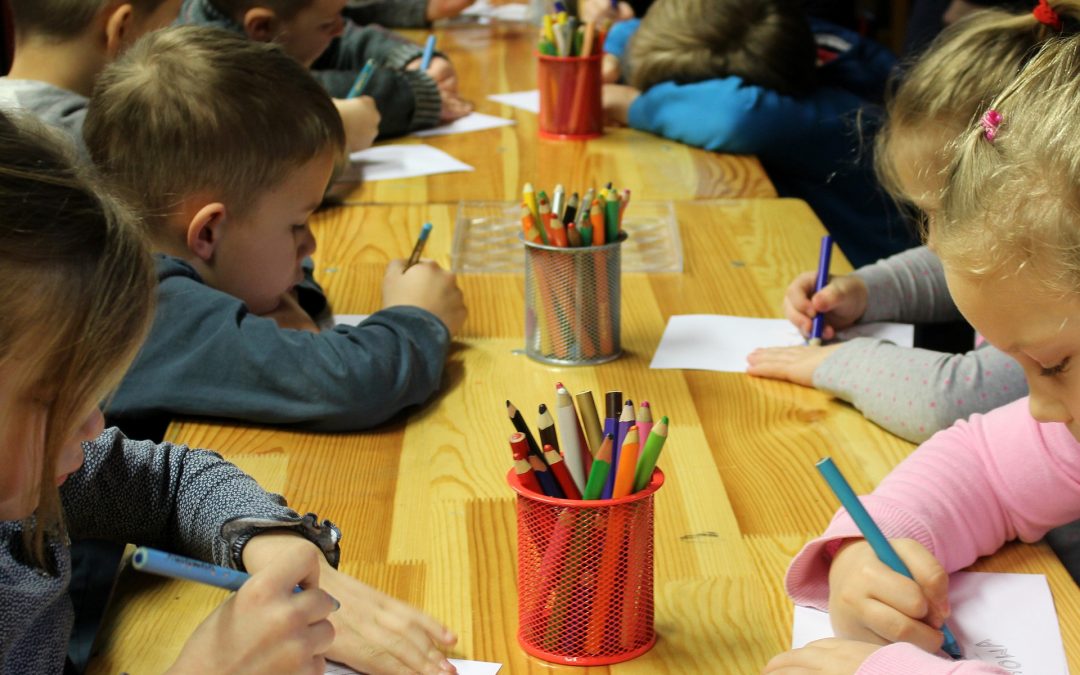
by Leslie Moldenauer | | Mind
Life is tough and sometimes things seem out of our control, where the only power that we have is the power over our emotions. That is not so easy for our youth, but providing them with a few tricks can help them to feel calm, empowered, and in control of their emotions. Here are a few breathing exercises to calm children of all ages, and put a smile back on their face.
The single most powerful thing that we can do at any given time is to work to control our breath through diaphragmatic breathing. If I had a dollar for every time I had a student tell me, “I breathe all the time, it has not worked for me yet”, I could buy myself a snazzy dinner on the town.
Here is the thing, concentrating on our breath does a few things simultaneously:
- It activates our parasympathetic nervous system. This is necessary to disengage from the sympathetic nervous system when we are under stress, anxiety, or even when feeling panicked.
- It allows our minds to slow down for a moment. Breathing exercises will allow our minds to stop overthinking about the current moment (somewhat similar to the effects of meditation, which can be challenging for some).
- If we can begin to slow our rate of breath, and in turn our heart rate, and racing thoughts….we are much more equipped to think clearly. When we are in a state of panic, rational through goes out the window and problem solving, or considering the big picture in a situation is all but impossible. This is the moment when children tend to act impulsively and get themselves into trouble in-home or at school.
The Basics-When we are anxious or stressed we tend to breathe through our chest, which has been shown to not only decrease the amount of oxygen to the brain but increases stress and anxiety. Diaphragmatic breath, also called belly breathing or breathing fully into your diaphragm, is the first thing taught in meditation or yoga and has been shown to increase relaxation and slow rate of breath along with blood pressure.
Teaching children of any age specific breathing exercises is relatively easy but needs to be repeated for it to become a habit. Dependent on your child’s age and weight, find an object to place on the belly. An adult would look to use a 10lb bag of rice or something similar, and a 1st or second grader possibly a book. Find something suitable for the size and age of the individual. Caretaker, you may want to practice this yourself before you teach it. Lie on your back in a comfortable position. A small pillow under your head and rolled up towel or blanket under your knees may help you to get comfortable. Place the weight on your abdomen. Begin to breathe, focusing on pushing the item up as you inhale, and letting it sink back down as you exhale. Both the in and out breathe should be through your nose, not your mouth. The key is slow, even breathing throughout the practice, just 3-5 minutes to start, and slowly working your way up to longer lengths of time.
Try and practice this periodically throughout the day without the weight on your belly, until it becomes more of a habit. This is the type of breathing that you should be doing throughout your day, especially if you have anxiety. Here are a few additional breathing exercises that can help your child become successful at using their breath to find calm and be centered. These can be used for children in Kindergarten through 8th grade.
Rainbow, or color breathing– This works especially well for the littles, but can be beneficial for everyone. Have them pick a favorite color, close their eyes and begin to breathe in a rainbow pattern, up and around and back down to the other end (just like a rainbow shape). Breathing in that color in their mind, or a favorite item of that color to the top of the rainbow’s bend, then exhale back to the other side and repeat. This takes the focus away from their current state to focus on the color, and works wonders for a child that cannot simply ‘breathe’. (You can find alternate variations of this technique on the Internet, creator unknown)
Following shapes-For this exercise, I recommend using a triangle or a square drawn on a piece of paper (having a clear path for inhalation and exhalation). Having a child follow the path of shape with their finger, a crayon, or a marker while focusing on their breath can be a very soothing experience. Really….it could be any shape or image that a child loves!
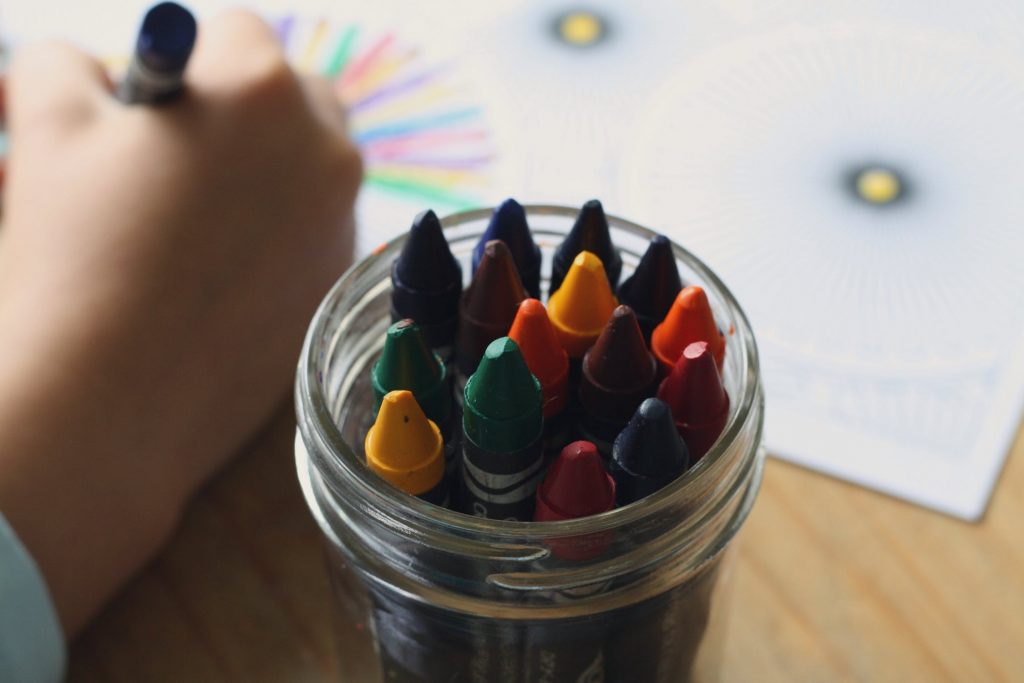
Blowing bubbles, squeezing Play-doh or slime. Having a child focusing only on that and deep breaths can help, much like a fidget spinner. The sensory play while breathing can help quickly to calm an irritated or anxious child.
These are just three examples of breathing exercises for all ages. Simply telling a child to practice slower breathing will not be as effective otherwise, or my least favorite statement to make to a child, ‘focus’. More on that in my article on focus here. I have used this skill without the belly practice in my small classrooms with great success. When we can not lay on the floor, I have them place one hand on their belly to practice.
These breathing exercises for children are but one small step in stretching the skills of our youth for their own emotional wellness.
Like so many practices in life, I encourage you to become educated on the proper use of essential oils. When using them, please do so cautiously, understanding that there is often misinformation on the internet. You can be assured that I support only educated and proven resources. While essential oils should not be feared they should be respected and used properly to ensure the safety of the individuals using them.
Please note that I am not a medical practitioner. The content of this website is provided for general informational purposes only and is not intended as, nor should it be considered a substitute for, professional medical advice. Do not use the information on this website for diagnosing or treating any medical or health condition. If you have or suspect you have a medical problem, promptly contact your professional healthcare provider. By using this website, you assume full responsibility and liability for your own actions.
Coping skills, resilience, and stress levels in our youngest generation











